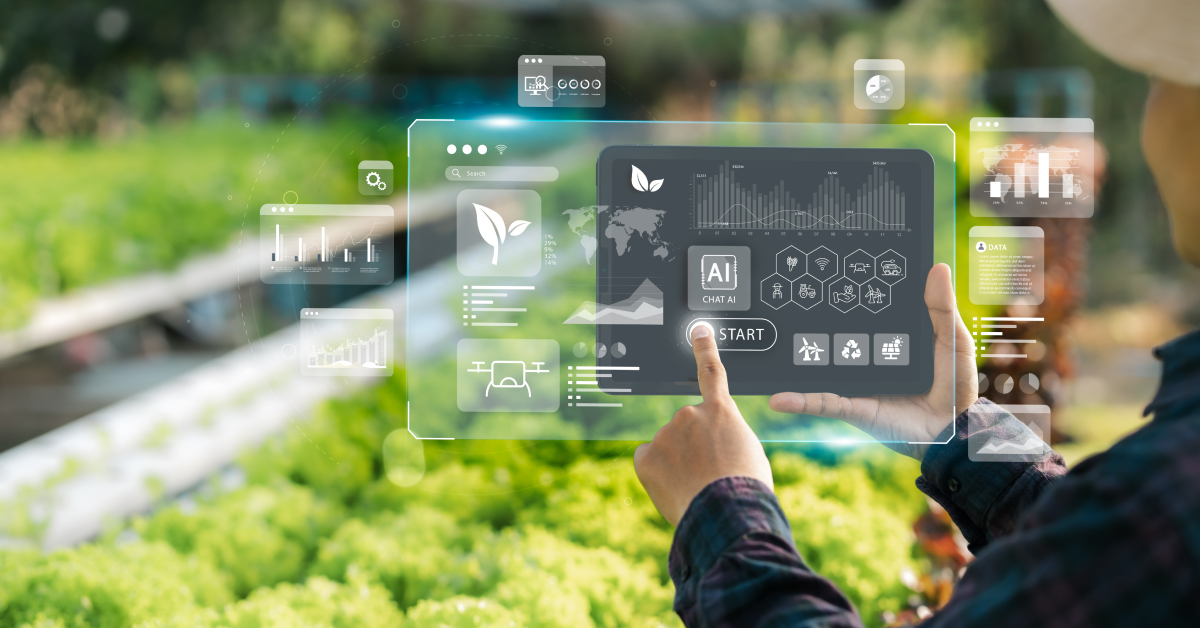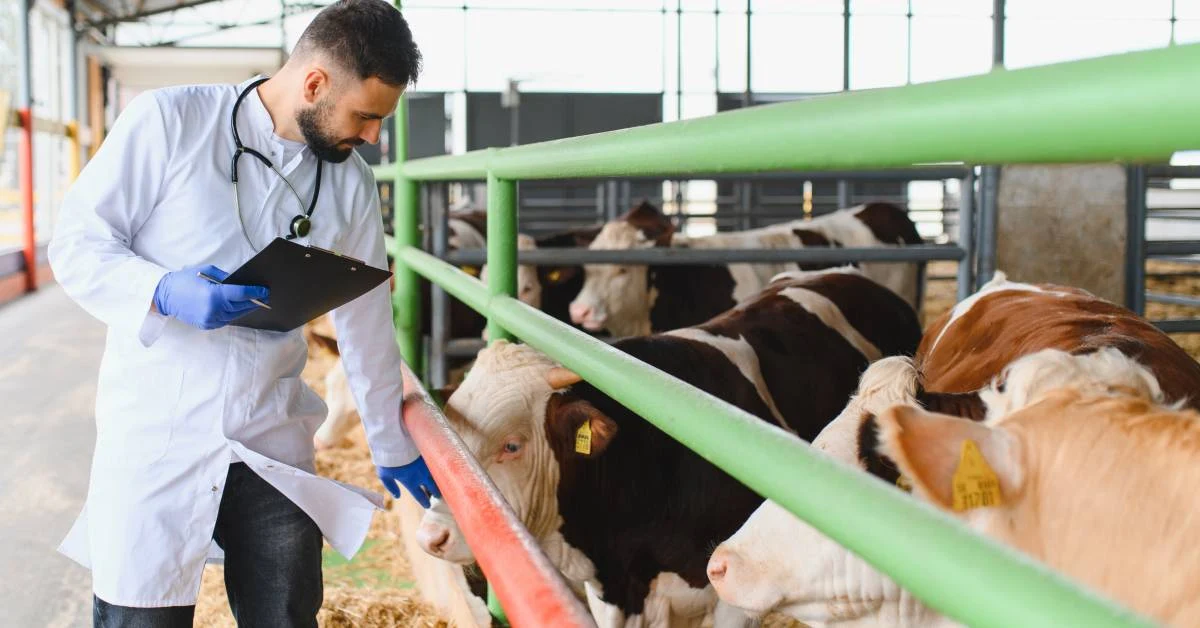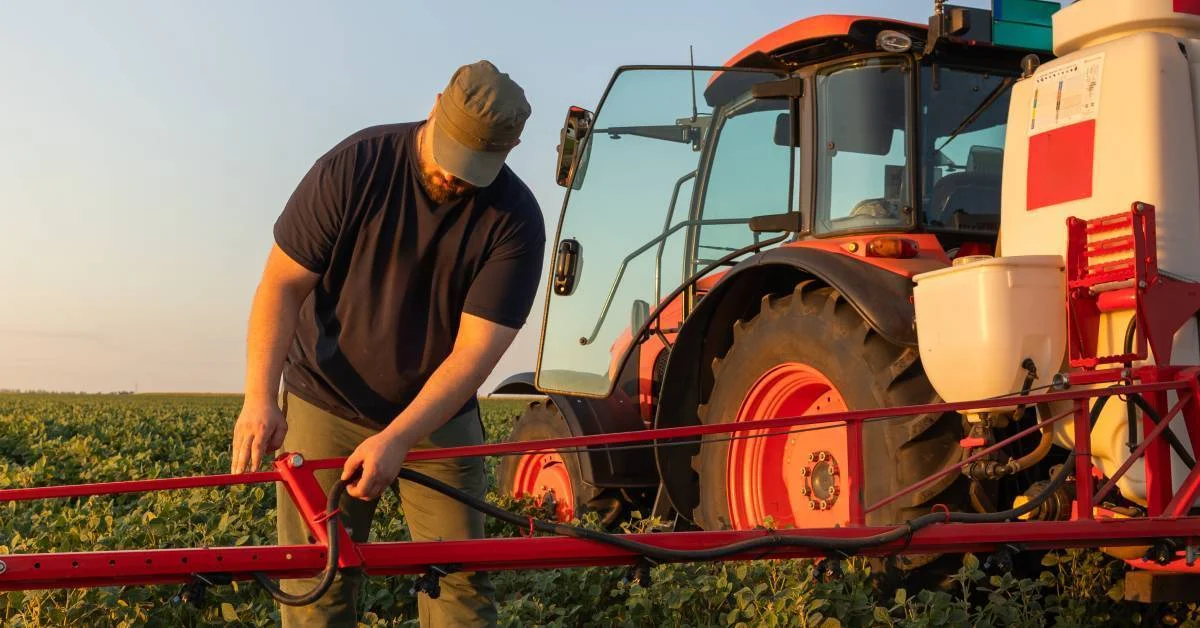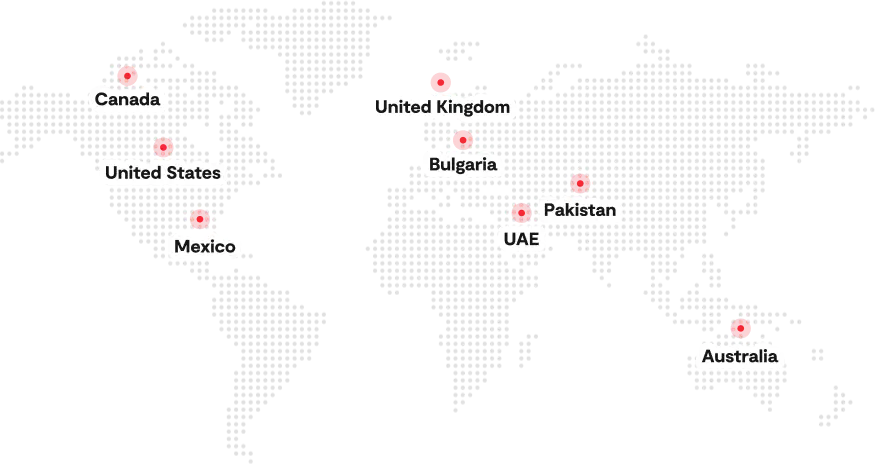Managing farm data isn’t just about collecting numbers; it’s about making those numbers work for the land, the livestock, and the bottom line. In today’s agricultural industry, farm data management can become overwhelming as operations expand, technologies change, and regulatory demands tighten.
Modern farms generate enormous volumes of data daily, from satellite imagery and weather models to soil moisture levels and harvest analytics. Managing this data effectively is no longer a luxury; it’s a necessity. When managed well, data leads to improved decision-making, reduced waste, higher yields, and more sustainable operations.
Ineffective data management, on the other hand, leads to missed opportunities, resource inefficiencies, and reactive farming decisions that cost time and money. This blog outlines the most common challenges farmers face in farm data management, as well as modern, technology-driven solutions to help them overcome these challenges.
Why Farm Data Management is Important Today
Today’s farmers are expected to manage operations with the efficiency of a logistics company and the accuracy of a financial analyst, all while responding to unpredictable weather patterns and shifting market demands. None of this is possible without robust farm data management systems.
When done right, farm data management unlocks several benefits:
- Better resource optimization using site-specific application of water, fertilizer, and crop protection products.
- Compliance with traceability and sustainability standards, which are now critical for international markets.
- Improved supply chain visibility, giving producers more control over post-harvest logistics and pricing.
- Environmental sustainability is achieved by reducing the over-application of inputs and preserving soil health.
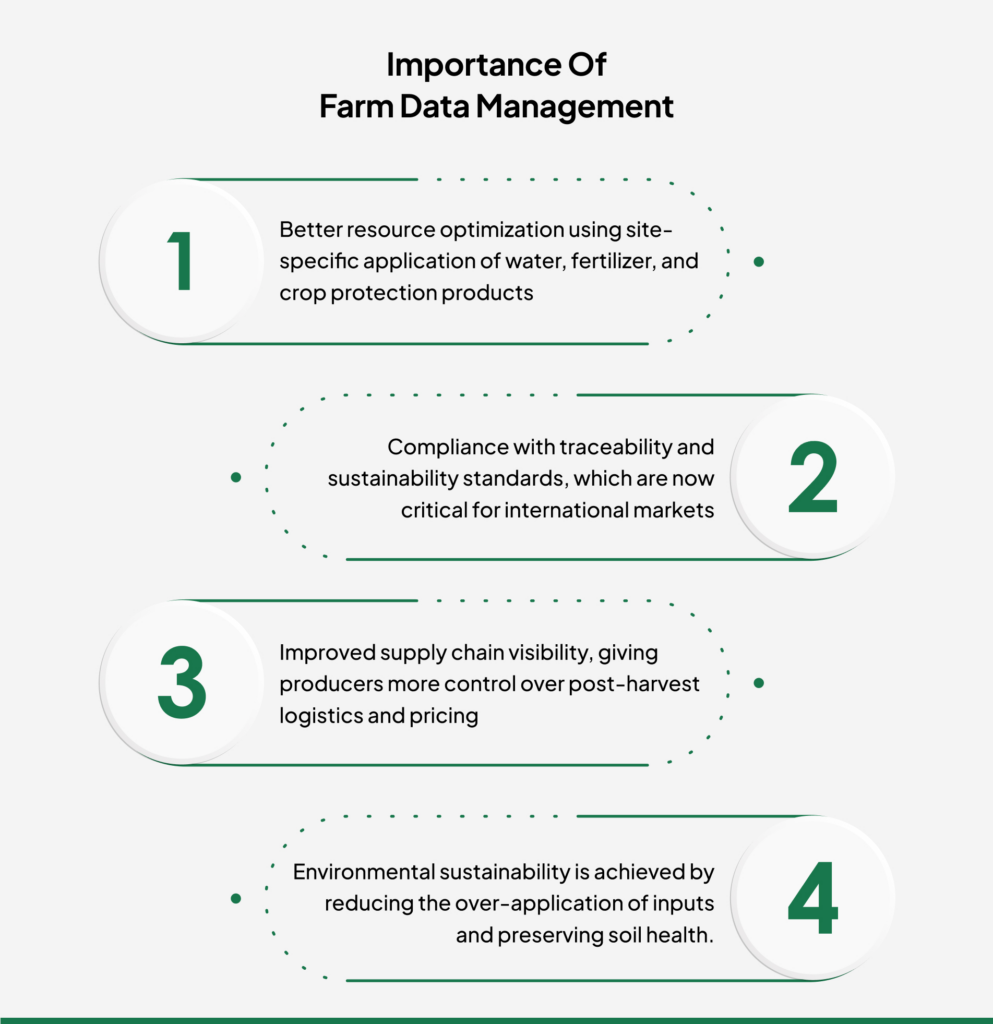
Common Challenges in Farm Data Management
1. Data Fragmentation Across Systems
Many farms still rely on standalone tools and equipment that don’t talk to each other. Equipment manufacturers often develop proprietary platforms, resulting in incompatible formats and disconnected systems. One system may capture crop input data, while another tracks irrigation events or weather conditions. Without interoperability, farmers are left stitching together spreadsheets or manually consolidating records.
According to many agricultural professionals, a lack of essential record-keeping knowledge affects farmers’ effective adoption of technology. This fragmentation prevents the creation of a complete picture of farm performance, making it challenging to analyze operations holistically.
2. Lack of Real-Time Data Access
Agriculture is highly time-sensitive. Decisions around harvesting, spraying, or livestock treatment must be made quickly. Yet, many farms still operate in delay cycles, collecting field data manually and entering it into systems hours or even days later. Without real-time farm data management, opportunities for quick intervention are lost.
For instance, a moisture sensor that alerts a farmer to dry conditions in one area of a field can help prevent crop stress, but only if it is received promptly. Real-time access is the difference between proactive and reactive management.
3. Poor Data Quality and Inaccuracy
Low-quality data is often worse than no data at all. Inaccuracies caused by human error, mislabelling, or outdated hardware can lead to misleading decisions. A simple data entry error, such as recording an incorrect field treatment rate, can result in compliance violations or economic losses. To improve accuracy and reduce human-driven inconsistencies, some farms now run digital records and reports through an AI checker before submission, helping verify clarity, completeness, and formatting consistency.
Weather forecasts, satellite imagery, and yield data must be consistent and reliable to inform actions. When data is inconsistent across platforms, it weakens the value of predictive models and trend analyses.
4. Low Adoption of Digital Tools by Farmers
Despite the availability of farm data management software, its adoption is still limited in many regions. Reasons for low adoption include:
- Complexity of available systems
- Lack of training or digital literacy
- High upfront costs
- Poor internet connectivity in rural areas
Low adoption of data tools is often due to unclear benefits. Still, when USDA compliance management software simplifies audits and record-keeping, it gives farmers a strong reason to digitize, making data management more purposeful, practical, and worth adopting.
5. Security & Data Ownership Concerns
As data becomes a valuable asset, questions of ownership and privacy arise. Farmers often hesitate to adopt digital platforms without clear policies on data usage. Concerns include:
- Who owns the data collected by third-party platforms?
- Can the data be shared or sold without the farmer’s consent?
- What cybersecurity and physical data center security protections are in place?
Data governance is crucial to building trust. The U.S. Government Accountability Office (GAO) has also emphasized the need for transparent data use policies in agtech platforms. (GAO)
6. Lack of Actionable Insights
Collecting data is only the first step. The real value lies in translating that data into actionable insights. Unfortunately, many platforms focus on reporting rather than decision support. Farmers are left with rows of charts and graphs, but no clear recommendations.
A deep understanding of data in modern farming is essential to move beyond tracking and toward strategies that improve outcomes. Without contextual intelligence, such as alerts about crop stress, pest pressure, or market trends, data can become overwhelming. Farmers need farm data management tools that surface “what to do next” instead of just “what happened.”
7. Integration with Legacy Systems
Older systems and equipment are still widely used on farms, particularly in developing markets or small-scale operations. These systems often lack modern connectivity features and require manual exports or workarounds, sometimes involving solutions like custom cable assembly, to sync with newer platforms.
Rebuilding IT infrastructure from scratch is not feasible for most growers. Any modern farm data management system must accommodate these legacy tools or provide a phased upgrade path.
How to Overcome These Challenges with Modern Solutions
1. Adopt a Unified Farm Management Platform
The first step toward overcoming data silos is adopting a centralized system. An end-to-end farm data management software brings together all data points, machinery data, satellite imagery, livestock records, and crop inputs into one accessible dashboard to improve crop yield and efficiency.
By adopting modern tools with integrated analytics and custom reporting, farmers can overcome today’s challenges more effectively. The role of big data in agriculture shines through in faster decisions, fewer errors, and clearer, team-wide alignment on data-driven strategies.
2. Use IoT and Cloud-Based Systems for Real-Time Monitoring
Cloud-connected sensors, drones, and GPS-equipped equipment enable continuous data collection and transmission. IoT-enabled devices can monitor soil moisture, livestock behavior, or pest pressure, and send alerts to mobile devices.
Using IoT and cloud-based systems makes real-time monitoring possible on the farm. Cloud platforms like Microsoft Azure and AWS, used globally for secure data handling, allow live field and livestock data to be streamed and stored. For farms that also need to share large sensor datasets or compliance documents from on-premise servers while keeping them protected, a VPN-less file-access solution like MyWorkDrive makes those files securely available to agronomists and partners anywhere, without the complexity of a VPN app apk. This supports smarter farm data management, helping farmers take timely actions like spot spraying or treating animals based on current conditions.
3. Ensure Data Validation and Standardization
High-quality data starts with rigorous validation and consistent formatting. Built-in templates, drop-down fields, auto-calculations, and error alerts help standardize data at the source. Standardized data enables better aggregation, benchmarking, and modeling.
With proper farm data management systems, farms benefit from tools that clean and normalize incoming data. This prevents flawed analytics and ensures that machine learning algorithms produce reliable results.
4. Offer Farmer-Friendly Interfaces
One of the major contributors to low adoption is system complexity. Intuitive design, offline capabilities, and mobile support help drive engagement. Folio3 AgTech prioritizes the farmer experience with smart dashboards and customizable views that suit different roles, from field workers to agronomists and managers.
Even multi-generational farm operators with limited tech experience can easily learn and use the platform. Support for local languages and hands-on training also fosters long-term user confidence.
5. Implement Strong Data Governance Policies
Farmers must be confident that their data is secure and under their control. Tools that ensure all customer data is encrypted, stored securely, and never shared without explicit consent, foster trust and credibility. Ownership terms are transparent, and farms retain full rights to their data.
Compliance with international standards, such as GDPR and ISO 27001, further assures farmers that the platform is secure and maintains integrity.
6. Generate Actionable Reports with AI & BI Tools
By combining historical patterns with real-time inputs, AI algorithms can predict crop diseases, assess yield variability, and optimize input application schedules with greater precision. Business intelligence (BI) tools enhance this process by visualizing key financial metrics, labor costs, and operational KPIs, turning raw data into clear, actionable insights.
Solutions that integrate AI and Power BI for agriculture enable farmers to make informed decisions through intuitive dashboards and predictive alerts based on their specific needs. Instead of relying on static spreadsheets, farmers receive dynamic reports aligned with their crops, geography, and operational goals.
Companies like Folio3 AgTech support this transformation by offering unified platforms that simplify data interpretation. Tools such as farm record-keeping software not only centralize farm activities but also integrate sensor data, remote imagery, and machine outputs, delivering a comprehensive view of the farm.
7. Integration with Existing Infrastructure
Modern platforms must support backward compatibility. This avoids the need for hardware replacement and ensures data continues to flow uninterrupted during digital transformation, especially in the agriculture industry.
By enabling step-by-step upgrades, farms can gradually adopt modern tools, maximizing ROI and minimizing downtime.
Conclusion
The road to smart farming begins with mastering farm data management. As farms grow more complex and resource constraints tighten, data will increasingly determine who thrives and who falls behind.
Challenges such as fragmented systems, poor data quality, low tool adoption, and integration hurdles are significant, but solvable. With modern farm management platforms, growers gain access to tools that not only centralize data but also enhance its usability, reliability, and strategic value.
Whether you’re managing thousands of acres or a diversified smallholding, the future of farming depends on your ability to convert data into action. With the right systems in place, that future looks not only manageable, but profitable and sustainable.
FAQs
What Is Farm Data Management, And Why Is It Essential?
Farm data management refers to the process of collecting, storing, analyzing, and using data from various farming operations to make better decisions. It helps improve efficiency, optimize inputs, comply with regulations, and enhance profitability.
How Does Folio3 AgTech Help With Farm Data Management?
Folio3 AgTech offers an integrated platform that consolidates data from multiple sources, provides analytics, and enables real-time insights-based actions. It also offers secure data storage and supports integration with legacy systems.
Is Farm Data Secure When Using Cloud Platforms?
Yes. Reputable providers use encryption, access controls, and compliance frameworks (such as GDPR and ISO) to ensure that farm data is safe and under the user’s control.
How Can Small Farms Affordably Adopt Digital Tools?
Many platforms offer modular pricing and mobile-friendly interfaces. These allow small farms to adopt only the features they need without significant upfront investments.
What Is The Role Of IoT In Modern Farm Data Management?
IoT devices enable real-time monitoring of soil, weather, and livestock. This data, when integrated into farm data management systems, allows for timely interventions and data-driven decisions.

